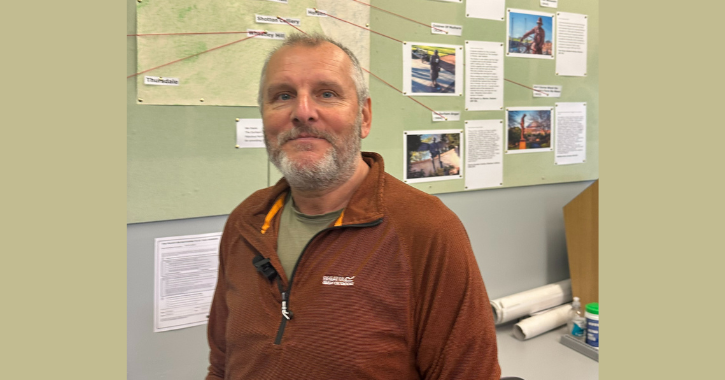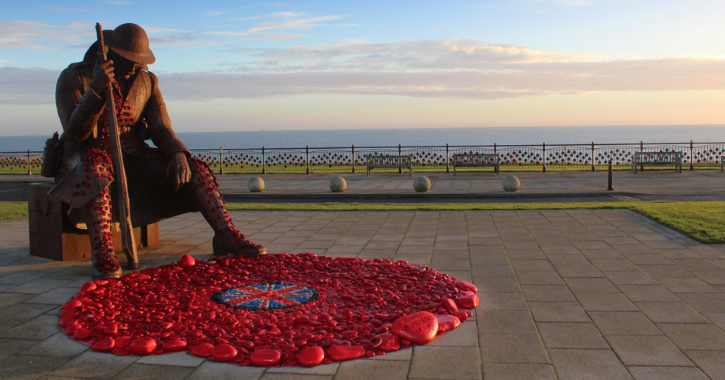Durham isn’t just a place of rolling hills and historic cities, it’s also an open-air gallery, filled with powerful steel sculptures by Ray Lonsdale, the Durham-born artist whose work has become part of the North East’s cultural heartbeat.
From Seaham’s harbour front to the villages and parks of East Durham, Ray's incredible artwork is scattered across villages and towns easy to explore by foot or bus. Making this the perfect slow-travel art trail for curious couples and adventurous families.
This blog will guide you through the must-see pieces across the county, give you precise locations (including What3words), and show you how to visit.

Why Ray Lonsdale Matters (and why you should visit)
Ray Lonsdale is a Durham-born former steel fabricator whose sculptural practice has captured hearts across the North East and the wider world. Working primarily in corten (weathering) steel, his figures evoke both strength and vulnerability, often paying homage to miners, soldiers, mothers, and other local stories.
His works aren’t hidden in galleries, they are in public spaces, meaning there is no admission, and the art becomes part of everyday life. As locals and visitors adopt them, they become landmarks, meeting points, and conversation starters.
If you’re planning a day out (or multiple days), these sculptures make a powerful pit-stop for any itinerary.
Map of Sculptures
The map below pinpoints the current 13 public Ray Lonsdale artworks across Durham you can visit any time of year.
Each Piece tells a story
From seaside soldiers to stoic miners, Lonsdale’s figures tell stories of community, courage, love and loss, often with a touch of poetry welded in.
.png)
Bonnie Pit Lad
Where? Dodds Close, Wheatley Hill, Durham, DH6 3QT.
What3words: prowess.yacht.duke
Public Transport: The closest bus stop is on Patton Walk, where the number 22 Arriva bus between Durham and Sunderland stops.
A tribute to the young miners, boys who started working underground at just 12 or 13. The “Bonnie Pit Lad” captures the pride, toughness and tragedy of youth in hard labour. It’s one of Lonsdale’s gentler pieces, a reminder that bravery isn’t only found on battlefields.
Children of Mothers
Where? Cenopath, 48 Church Lane, Murton, SR7 9RL.
What3words: wove.feed.analogy
Public Transport: There is a bus stop at the Cenopath, Go North East bus services 61 (Sunderland to Peterlee) and 861 (Seaham to Murton) stop here.
Installed next to Murton’s war memorial, this piece honours the mothers who waited at home, those whose strength often went unseen. It’s understated but deeply emotional, giving space to reflection and remembrance.
Top tip - Combine with a trip to Murton Heritage Trail or Dalton Park for a mix of culture and coffee.
.png)
Eleven ’o’ One (Tommy)
Where? Terrace Green, Seaham, SR7 7EU.
What3words: fidelity.diary,tiles
Public Transport: The cloest bus stop is at Seaham Interchange. Go North East bus services 60 (Sunderland to Parkside), X6 (Sunderland to Peterlee) and 71 (Seaham to Chester-le-Street) stop here.
Lonsdale’s most famous piece, known simply as the Tommy sculpture by locals. 1101 depicts a First World War soldier in quiet reflection - head bowed, rifle resting, boots heavy with mud and memory.
“Eleven ’o’ One” refers to 11:01am on 11 November 1918 (the first minute of peace after the Great War). The sculpture was originally meant to be temporary, but locals loved it so much they raised over £100,000 to make it permanent. Today, it stands proud on Seaham sea front, rusted beautifully by salt air. A symbol of peace, endurance and community pride.
.png)
Heritage Blues
Where? Brandon Bus Turning Point, Brandon, DH7 8UR.
What3words: newest.vaild.camps
Public Transport: Bus services 49/49A (Durham to Brandon) and Go North East Angel 21 (Newcastle to Durham) stop here.
A kneeling miner holds a safety lamp, testing for air. A small, powerful gesture that once meant life or death. The sculpture’s title reflects both melancholy and pride: the “blues” of the miner’s life, and the resilience of Durham’s heritage.
I Ain’t Gonna Work on Maggie’s Farm No More
Where? Horden Welfare Park, Horden, Peterlee, SR8 4DE.
What3words: issues.tools.format
Public Transport: Cloest bus stop is The Bell. Go North East bus services 208 (Peterlee to Easington) and X62 (Peterlee to Durham) stop here.
Taking its title from a Bob Dylan song, this piece speaks to protest, pride and independence. It reflects the frustration and defiance felt during the 1980s mining closures, the human cost of economic change.
Top tip: Combine this with a walk through Horden Welfare Park and nearby coastal paths.
.png)
Not Much to Ask
Where: Aged Mine Workers War Memorial Homes, Tursdale, DH6 5PA.
What3words: reception.cucumber.stage
The name says it all - a heartfelt piece about ordinary dignity. Though smaller and quieter than some, this work captures the essence of Lonsdale’s style: stillness, resilience, and a subtle emotional punch.
.png)
Relative Treats
Where? South Hetton Welfare Park, South Hetton, DH6 2SJ.
What3words: utensil.fully.braced
Public Transport: The nearest stop is Welfare Crescent Shops or the cricket club. Services include: From Peterlee 61, X1 and X62. From Sunderland 6, X62 from Durham Bus Station, and X1 from Newcastle.
A grandmother and granddaughter, frozen in a moment of quiet affection. Unlike the soldiers and miners, Relative Treats celebrates simple, domestic love, family bonds and the everyday joys that hold communities together.
It’s small, sweet, and full of heart. Proof that public art doesn’t have to be grand to be meaningful.
The Ball and the Bradford Boy
Where: 27 Main Street, Witton Park, Bishop Auckland, DL14 0DY.
What3words: introduce.wheels.loses
Public Transport: Service 87 (Bishop Auckland to Toft Hill) stops right by the scultpture.
In this peaceful memorial garden, Lonsdale honours the Bradford brothers and other soldiers from Witton Park who fought in WW1. The Bradford brothers, also known as the 'Fighting Bradfords' are believed to be the most decorated family of the First World War, with two Victoria Crosses, one Distinguished Service Order, two Military Crosses and three Mentions in Despatches between them. Out of the four brothers, only one survived the conflict, making the sculpture a moving reminder of a family's tragic loss.
The sculpture shows a young soldier cradling a ball, symbolising both play and fragility. The garden is a perfect picnic stop or reflective rest spot on a countryside ramble.
Getting there: Take a bus from Bishop Auckland or a scenic drive along the A689.
.png)
The Coxwain
Where? Seaham Harbour Marina, Seaham, SR7 7EE.
What3words: supple.silent.fidgeted
Public Transport: The cloest bus stop is at Seaham Interchange. Go North East bus services 60 (Sunderland to Parkside), X6 (Sunderland to Peterlee) and 71 (Seaham to Chester-le-Street) stop here.
A tribute to the RNLI’s George Elmy lifeboat and the five volunteers who lost their lives in a tragic 1962 rescue. The life-sized steel figure leans forward at the helm, braced against imagined waves. Strength and sorrow frozen in motion.
The plinth resembles a boat deck, and the nearby Heritage Lifeboat Centre tells the full story of the Elmy Lifeboat disaster, which claimed the lives of five crew and four individuals from the Economy fishing vessel.
Top tip: Combine a visit with coffee at the marina’s cafés, or make it stop two on your Seaham sculpture stroll.
.png)
The Durham Angel
Where? Horns Garden Centre, Dixon Estate, Shotton Colliery, DH6 2PX.
What3words: outnumber.cabbages.corrects
Public Transport: Nearest bus stop is at Dixon Estate. Arriva bus services 22 (Durham to Sunderland) and X22 (Middlesbrough to Peterlee) stop here.
One of Lonsdale’s earliest and most striking symbolic works. The Durham Angel also known as 'Horns' stretches tall and calm among greenery, a rusted guardian watching over the county. Its wings are abstract, industrial, almost mechanical, a meeting of faith and engineering.
Ray was originally commissioned to make a smaller copy of the Angel of the North, but taking inspiration he made his own version, 12 foot high and has a wingspan of 22 feet.
The Last Shift
Where? Cemetery Road, Wheatley Hill, DH6 3JZ.
What3words: tend.dices.escapades
Public Transport: The cloest bus stop is at Cemetery Gates. Arriva bus services 22 (Durham to Sunderland) and 58 (Durham to Hartlepool) stop here.
A fittingly placed memorial, The Last Shift commemorates the final working day of a miner and, symbolically, the end of an era. It’s based on a photo of Tom Davies, a local miner, complete with cigarette and powder-box.
Set among headstones and wildflowers, the sculpture bridges life and labour, work and rest. It’s a deeply moving stop for anyone tracing Durham’s industrial story.
.png)
The Village Remains
Where? Robin Todd Community Centre, South Hetton, DH6 2TH.
What3words: tucked.choirs.wash
Public Transport: The cloest bus stop is at the Health Centre. Go North East bus services 61 (Sunderland to Peterlee), X62 (Peterlee to Durham) and X1 (Newcastle to Peterlee) stop here.
Also known locally as 'The Last Tub' it depicts a miner pushes his final tub of coal, glancing back at the life he’s leaving behind. Around the base are bricks engraved with the names of men who worked in South Hetton Colliery.
It’s both memorial and monument, a tribute to generations who kept the lights on, quite literally. Behind the sculpture, a mural shows the pithead and colliery days, tying past to present.
Then Gone
Where? Bells Fish and Chips, North Terrace, Seaham, SR7 7HA.
What3words: epic.adverbs.clotting
Public Transport: The cloest bus stop is at Seaham Interchange. Go North East bus services 60 (Sunderland to Parkside), X6 (Sunderland to Peterlee) and 71 (Seaham to Chester-le-Street) stop here.
Lonsdale’s newest addition (2025), Then Gone is a towering miner, seven times life-size, dedicated to Seaham’s industrial past. He looms large over the street, a ghost of the coalfields, reminding passers-by that the mines might be gone, but their spirit remains.
Nicknamed George, this piece was commissioned by Bells owner Graham Kennedy to pay tribute to the town’s long and rich mining, and his Father and Father in Law, who both worked in local mines.
Local tip: Grab some chips from Bell’s, sit opposite “George” (as locals affectionately call him), and enjoy art with your lunch.

Suggested Itineraries & Public Transport Tips
Here are a few ideas for how to see these sculptures, especially using public transport and walking:
Option A: Seaham Focused Day
1. Start at Seaham train station. From the station, walk toward the seafront (about 15–20 mins, or catch a local bus).
2. Visit Eleven ’o’ One (Tommy / 1101)
3. Walk along the seafront and down to harbour to see The Coxwain.
4. Continue to Then Gone at Bell’s Fish Shop, opposite the entrance to the Harbour Marina.
5. Return via a local bus toward Murton to see Children of Mothers. This short loop gives you three major works in one manageable walk and bus ride.
Option B: East Durham Sculpture Trail
1. Use buses (e.g. from Seaham or Peterlee) to reach South Hetton. Visit The Village Remains, then walk or catch connecting bus to Relative Treats in the same welfare park.
2. Travel onward toward Wheatley Hill (via local bus) to find The Last Shift in the cemetery and Bonnie Pit Lad.
3. From there, you might try heading to West Cornforth for Not Much to Ask.
Option C: Wider Durham / Witton Park
1. Use a regional bus to Witton Park. Visit The Ball & the Bradford Boy.
2. Then detour via Brandon to see Heritage Blues.
3. If time allows, go toward Horns Garden Centre (Shotton) to see The Durham Angel.
Top Tips for Visitors
- Use What3words to lock onto precise locations, especially useful when walking or exploring rural spots.
- Travel via public transport and walking. Many of these are within walking distance from bus stops or train stations. Durham and Sunderland’s local bus networks are useful for reaching villages in East Durham.
- Bring a good map or offline phone mapping app (with pin drops).
- Plan by grouping nearby sculptures to minimise long detours.
- Photograph and share on social media (with tags or location names). Public art thrives when people talk about it.
- Check local bus schedules ahead. Some rural routes run infrequently on weekends.
- Visit early morning or late afternoon for better light and quieter surroundings.
Related
Comments
Nobody has commented on this post yet, why not send us your thoughts and be the first?



 to add an item to your Itinerary basket.
to add an item to your Itinerary basket.
.png)





